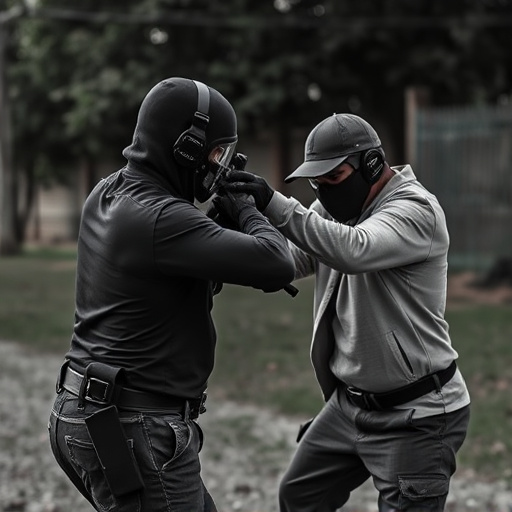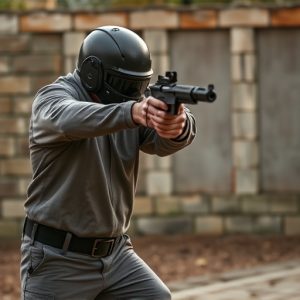Unveiling Compact Stun Guns with Flashlight: Current Spread Pattern Analysis
Optimizing the design and performance of compact stun guns with flashlights requires understanding c…….
Optimizing the design and performance of compact stun guns with flashlights requires understanding current spread patterns in diverse materials. This knowledge allows engineers to make precise material and circuit choices, improving efficiency, safety, and user experience. By analyzing electricity flow, they can enhance output power, flashlight intensity, and device longevity, ensuring optimal functionality without compromising safety. These integrated devices combine self-defense capabilities with illumination, making them a reliable personal defense solution in low-light conditions while meeting strict safety standards.
Electrical current spread patterns are crucial in understanding the performance and safety of compact stun guns with integrated flashlights. This article delves into the analysis of these patterns, providing a comprehensive foundation for their significance. We explore how compact stun guns with flashlights operate on a technical level, examining their unique electrical characteristics. Furthermore, we discuss practical applications and considerations in current spread pattern analysis, highlighting key insights for users and professionals alike.
- Understanding Current Spread Patterns: A Foundation for Analysis
- Compact Stun Guns with Flashlight: Unveiling Their Electrical Characteristics
- Practical Applications and Considerations in Current Spread Pattern Analysis
Understanding Current Spread Patterns: A Foundation for Analysis

Understanding Current Spread Patterns forms the bedrock upon which in-depth analysis of electrical phenomena, especially in compact stun guns with flashlight functionalities, can be effectively conducted. These patterns delineate how electric current flows through diverse materials, offering crucial insights into performance characteristics and safety measures. By studying these spreads, engineers and researchers can optimize design parameters, enhancing both efficiency and user safety in compact devices that combine lighting and electrical shock capabilities.
This analysis is particularly relevant for compact stun guns with integrated flashlights, where precise current management is critical. In such devices, the interaction between the electrical current and various components—from conductors to insulation—directly impacts output power, flashlight intensity, and overall device longevity. Comprehending these spread patterns enables tailoring of materials and circuit designs to meet specific performance criteria, ensuring optimal user experience without compromising safety.
Compact Stun Guns with Flashlight: Unveiling Their Electrical Characteristics

Compact stun guns equipped with flashlights represent a unique fusion of self-defense technology and illumination, offering users versatility in both dangerous situations. These devices combine the power of an electric shock weapon with a built-in light source, providing a multi-functional tool for personal safety. The electrical characteristics of these compact weapons are designed to deliver a strong stun current while also ensuring user safety through proper insulation and control mechanisms.
The stun gun’s design focuses on efficient energy distribution along its contact points, enabling a quick and effective stun when activated. The flashlight component not only aids in low-light conditions but also serves as a deterrent by illuminating potential threats. This innovative integration of features makes compact stun guns with flashlights appealing to individuals seeking advanced personal defense solutions, combining light and power in a convenient, easily accessible device.
Practical Applications and Considerations in Current Spread Pattern Analysis

In practical terms, understanding current spread patterns is vital for a wide array of applications, from designing efficient electrical systems to ensuring safety in devices like compact stun guns with flashlights. By analyzing how electric current flows through various materials and components, engineers can optimize circuit designs, reduce power loss, and enhance overall performance. This is particularly crucial in compact electronics, where minimizing size and maximizing functionality are paramount.
In the context of compact stun guns with integrated flashlights, accurate pattern analysis enables manufacturers to ensure both reliable operation and user safety. It helps in determining optimal current distribution for efficient lighting while ensuring the electrical components can withstand the high currents associated with the stun function without overheating or failing. This balanced approach is essential for creating durable and effective personal defense tools that meet safety standards.
The analysis of electrical current spread patterns, as discussed in this article, is a crucial aspect of understanding compact stun guns with flashlight. By delving into these patterns, we gain valuable insights into their unique electrical characteristics and practical applications. This knowledge enables us to navigate the complexities of current flow, facilitating safer and more effective use cases for compact stun devices. Remember that, as technology advances, continued research in this area will further revolutionize their potential in personal safety and security.


